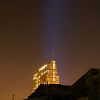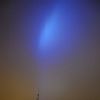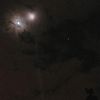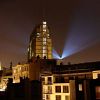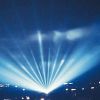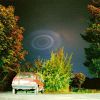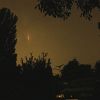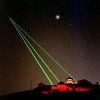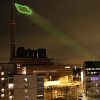Searchlights or spotlights project powerful beams of light of approximately parallel rays that can be directed to illuminate a precise location. As early as the end of the 19th century bright spotlights were widely used not only to illuminate important structures and buildings, but also as standard equipment of the main military forces around the world.
Examples of military uses for searchlights are:
- detection and illumination of enemy aircraft, especially on coastal artillery batteries
and on ships at sea
- forcing enemy bombers into higher altitudes
- blinding and confusing the crew of the enemy aircraft
- acting as beacons for the landing of damaged aircraft
- enabling the destruction of "flying bombs" in mid-air
- illumination of the battlefield for night attacks
- signalling other units and allied forces.
In the late 40s and early 50s, thousands of military posts in countries all over the world were equipped with powerful carbon arc searchlights to scrutinize the skies for enemy aircraft. Many UFO reports from the fifties that involve glowing discs moving rapidly through the skies were probably nothing but searchlights beams illuminating low clouds.
After WW2 many of the military searchlights were used for victory parades and ever since they have been associated with celebrations and special events, such as film premiers, concerts and grand openings.
In the 80s and 90s skytracers (a.k.a. skytrackers, skybeamers, skygazers, skyfasers and skyboosters) became popular eye catchers to lure youngsters to discos. In recent years stricter regulations, imposed after the publication of alarming studies on light pollution, resulted in a drop of the number of UFO reports caused by spotlights.
When a beam of light strikes the base of a low cloud deck or layer of haze, a round spot will appear. This light can be stationary, but when the spotlight moves, even at small angles of tilt, the illuminated patch on the cloud will move over a much wider angle in the sky, creating the impression of a round, luminous disc that moves through the air at a tremendous speed. Sometimes these ‘discs’ are seen to execute sharp angles, back-and-forth movements and other uncanny manoeuvres.
When the sky beneath the clouds is clear and free of aerosols, the beam itself becomes invisible. Because of this, observers sometimes believe that what they are seeing cannot be caused by a spotlight on the ground. The somewhat fuzzy edges of the reflected light often lead people to think that the lights belong to a solid object manoeuvring above the clouds.
When a light beam pierces through a thin layer of fog with clear air below and above, the impression may arise of a glowing cylinder hovering in mid air.
Large venues such as casinos, car shows and night clubs often rent sets of computer-controlled spotlights that can move around the sky in a set pattern. The beams from these spotlights project round light patches on the clouds (sometimes 20 or more simultaneously) that remain in formation as if attached to the bottom of a giant craft. These light carousels can spin round or split up with each light taking a different direction.
All colours are possible, but coloured lenses will reduce the light output (up to 25% for red lenses). The most typical colour is bluish-white. Xenon discharge lamps of 4000 Watt and more are not unusual and some displays can be seen up to distances of 20 km (12.4 miles) from their point of origin.
Another, much less common effect of spotlights or searchlights occurs when the light of the lamp is mirrored in high altitude ice-crystal clouds. In those instances, the reflected image will appear as a stationary, narrow streak of light. On rare occasions, these vertical light pillars can be seen in combination with the more common light patches darting over lower clouds, creating the illusion that disc-shaped lights are moving in and out of a vertically oriented luminous object. This situation only occurs when there's a low, broken cloud deck with gaps big enough for the stationary, pillar-shaped reflection to be visible through them.
Also included in this picture gallery are images of laser beams and their effects. Lasers typically have the aspect of a fine, well-defined focused ray, usually of a green colour (although other colours are possible as well). Connected to a computer, the rays can project graphic images on the base of a cloud-deck. Lasers can be used for a variety of purposes, including art projects and scientific research.
A much-heard description in UFO witness accounts is that the unidentified phenomenon was totally silent and disappeared "as if suddenly switched off", which is exactly what can be expected from luminous effects caused by spotlights and laser beams.
